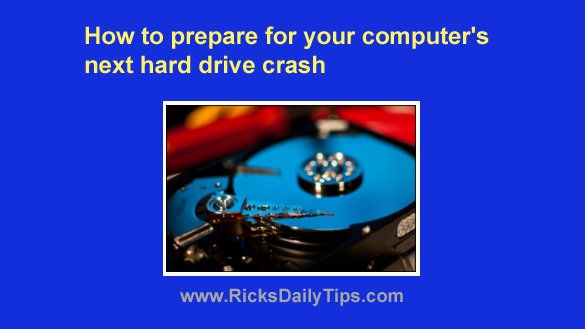
Want to get my easy to follow Tech Tips in your email?
Sign up for my daily Rick’s Tech Tips Newsletter!
Note: The links in this post are affiliate links.
Most people use their computers day in and day out, and chances are you do as well.
Do you ever think about what would happen if a hard drive crash or other disaster wiped away all of their precious files?
If your hard drive were to ever go belly-up or a virus leaves your computer unable to start up would you lose all of your photos, music, videos, emails and other irreplaceable files?
The fact is disasters such as this aren’t just something that could happen in the future. Truth be told, almost every long-time computer user will experience a crashed hard drive or some other file-destroying calamity at one time or another.
And by the way, if your computer has a solid state drive (SSD), that’s awesome! But always remember that SSDs can and do fail as well. That’s why you need to back them up too.
It’s a virtual certainty that sooner or later you’ll find yourself in a situation where all of your files are gone, never to be recovered if you haven’t taken the time to prepare by creating frequent backups.
When we speak of backups, there are actually two separate parts of your file system that you’ll need to protect:
1 – The Operating System
You’ll need some method of reinstalling the operating system in the event that your file system ever becomes so damaged or corrupted that the O.S. cannot be repaired.
If you have a set of recovery discs you’re all set. Simply replace the hard drive if needed, then boot the computer from an optical drive or USB recovery drive and reinstall the operating system.
But what if your computer didn’t come with a set of recovery discs? Very few new machines do these days.
Or what if it did come with the discs but they have been lost or damaged?
In either of those cases you’ll need to either order a set of discs from the support section of your computer manufacturer’s website or create a set of your own – but you’ll have to create it before your hard drive crashes.
Depending on the manufacturer you might be able to order a set of recovery discs for your PC by visiting their website’s “Support” section.
But luckily there’s a solution that works every time: Simply create a System Image Backup of your current Windows installation right now before tragedy has a chance to strike.
Note: You’ll find instructions for creating a System Image backup on your Windows version in these posts.
And you Mac owners can prepare for a similar disaster by backing up your drive with the handy Time Machine utility.
2 – Your Data Files
Many would argue that being able to restore your photos, music, videos, emails and other non-replaceable files is even more important than being able to restore the operating system.
After all, any Operating System can be replaced even if it means buying a new computer, but your personal, unique and irreplaceable files cannot.
There are a number of ways to back up your data files. You can copy them onto blank writable DVDs or onto one or more large USB flash drives. You can even upload them to the cloud using Dropbox, Google Drive or OneDrive.
The safest approach by far is to back up your files onto multiple media and then store them in multiple physical locations.
The best way to create a local backup is to buy an external USB hard drive and periodically create a backup set consisting of the aforementioned System Image Backup tool (or Time Machine if you’re a Mac owner). That way you’ll be backing up both the operating system and your data files at the same time.
After you have created a local backup, it’s also a good idea to back up your photos and other user-created files to the cloud.
Why? Because if you ever lose your local backup set to fire, flood or robbery, your files will still be safe and secure on a remote server, ready and waiting for you to restore them onto either a new hard drive or a new computer.
There are a number of good options for backing up to the cloud, but the one I recommend is Carbonite. I truly believe they offer the best value and service of all the automatic online backup solutions.
Bottom line: Hard drive and SSD crashes don’t just happen to other people. They can happen to anyone at any time, often without warning.
And unfortunately, when a drive crashes it usually takes all the files stored on it right to the grave with it.
Always remember this: If you ‘ll take the time to back up your computer’s hard drive or SSD early and often (both locally and online) you’ll never find yourself in the position of wishing you had.